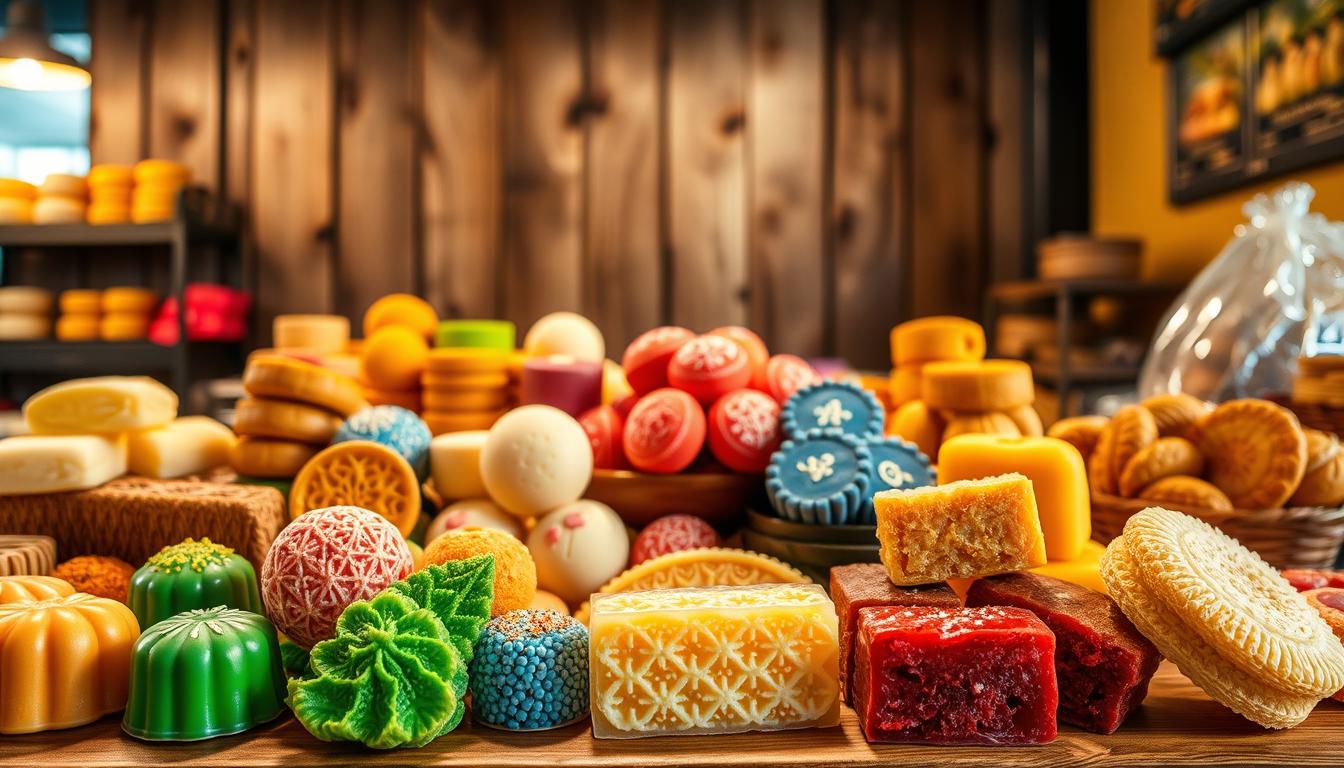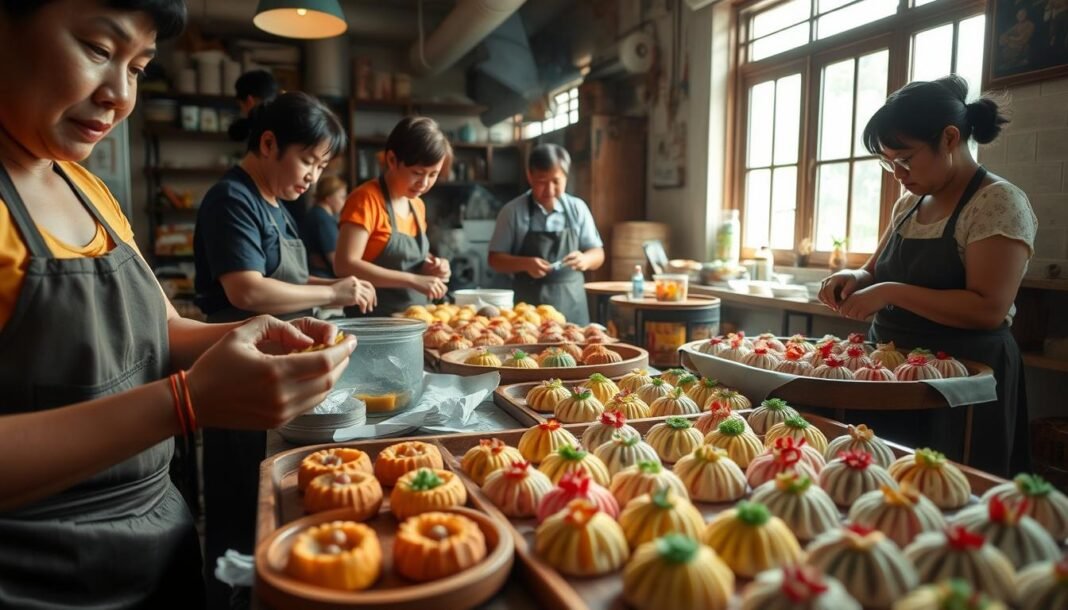Start a sweet adventure into Singapore’s food history with kueh workshop singapore. These small treats, known as Singapore kueh traditions, mix coconut, palm sugar, and rice flour. They tell stories passed down through generations.
Workshops at places like the Children’s Museum Singapore and community centers let you make these iconic snacks. You’ll learn to shape, steam, and enjoy these treats. Discover how to make kueh lapis, kueh bahulu, and more, connecting with local culture.

Whether you love baking or culture, these hands-on sessions are for you. You’ll learn to turn simple ingredients into art. It’s perfect for family gatherings or as gifts.
Each workshop celebrates heritage and encourages creativity. It turns beginners into confident kueh makers.
Key Takeaways
- Explore kueh workshop singapore events at venues like the Children’s Museum Singapore.
- Discover how Singapore kueh traditions reflect multicultural flavors and history.
- Learn essential skills to recreate classic recipes like kueh lapis and kueh dadar.
- Engage in interactive sessions blending heritage with modern baking techniques.
- Bring home newfound knowledge and a deeper appreciation for Singapore’s food culture.
Discover the Art of Kueh
Every kueh has a rich history and skill behind it. The art of kueh mixes tradition and creativity. It turns simple ingredients into beautiful food art. Each piece shows Singapore’s diverse culture through its designs.
Making kueh requires great skill. It involves techniques like steaming and shaping rice flour dough. Chefs in workshops teach these skills, showing how to layer fillings and shape the dough.
These methods keep the kueh’s tradition alive while allowing for new ideas. It’s a way to honor the past while exploring the future.
- Shaping: Using molds or hands to form intricate patterns
- Layering: Combining coconut, palm sugar, and glutinous rice for depth
- Seasonal ingredients: Adapting recipes with local fruits or spices
In Singapore, kueh is celebrated at festivals and food fairs. Workshops let you see how kueh making techniques change. They mix Malay, Chinese, and Indian styles. Learning these skills connects you to a long line of cooks who turned tradition into art.
Exploring Singaporean Kueh Traditions
Singapore’s kueh traditions tell a story of migration and cultural exchange. These treats have evolved from simple village recipes to the creations of modern bakeries. They reflect centuries of shared practices and ingredients.
A Brief History of Singaporean Kueh
The history of Singaporean kueh started with Malay communities using local ingredients like coconut and palm sugar. Chinese immigrants brought steamed rice-based desserts. Peranakan and Indonesian traditions added spices and intricate designs. Colonial trade routes introduced new tools and flavors, shaping today’s diverse offerings.
- 15th century: Malay kueh used coconut and banana leaf wraps.
- 19th century: Chinese communities popularized steamed kueh like kueh bakul.
- Early 20th century: Nyonya chefs perfected layered cakes like kueh lapis.
Cultural Influences and Regional Variations
Cultural influences have made kueh a culinary mosaic. Each community has left its mark through ingredients and techniques:
| Cultural Group | Signature Elements |
|---|---|
| Malay | Pandan leaves, coconut milk, and banana leaf packaging |
| Chinese | Rice flour, red bean paste, and festive molds |
| Peranakan | Colorful layers, spices like turmeric, and intricate patterns |
| Indonesian | Spiced fillings and baking methods |
Today, these traditions evolve with modern tastes while staying true to their roots. Every bite of kueh is a conversation between past and present.
Preparing for a Kueh Workshop Experience
Getting ready for a kueh workshop is more than just showing up. It’s a mix of tradition and creativity. First, read the workshop guidelines. Some workshops give you tools, while others ask you to bring your own.
Wear comfy clothes that won’t get in the way of cooking. Avoid loose fabrics near heat or steam.
- Arrive 10 minutes early to explore the kitchen setup.
- Carry a notepad to capture chef tips and technique tricks.
- Ask about cultural stories behind each step—like how coconut milk choices vary across Singapore’s neighborhoods.
Local workshops are like the Children’s Museum Singapore, where curiosity is key. Be ready to learn with an open mind. Chefs share stories of how kueh recipes changed from family kitchens to bakeries.
Bring a sense of adventure to enjoy mixing, shaping, and tasting. This makes the workshop a memorable experience, blending heritage with fun.
What to Expect at a kueh workshop singapore
Discover the fun of making kueh in a lively atmosphere. Workshops in Singapore mix cultural traditions with creative hands-on activities. They are perfect for families or solo learners, offering a space to spark curiosity and build connections.
Setting the Scene: Venue and Ambiance
Enter vibrant places like the Children’s Museum Singapore, where the workshop ambiance is full of energy. Ingredients are laid out in colors, and the smell of coconut milk and pandan leaves fills the air. At the Ang Ku Kueh Making Workshop, you’ll find cozy, sunlit rooms and friendly instructors ready to help.
Testimonials show how these settings turn learning into an exciting journey:
“Every corner feels like a story waiting to be baked.”

Interactive Learning and Hands-On Fun
These sessions are all about getting involved. At “The In-Kueh-Dible Party,” guests learn to mix, shape, and steam their creations with expert help. Activities include:
- Molding dough into traditional shapes like kueh lapis layers
- Tasting ingredients to understand flavor profiles
- Decorating kueh with edible flowers or sesame seeds
Workshops end with a tasting session, where everyone gets to enjoy their creations. Families leave with recipes and memories, eager to try making kueh at home.
Essential Tools and Ingredients
Mastering kueh needs the right tools and ingredients. These are key to capturing its cultural essence. Traditional essential kueh tools and ingredient secrets are at the heart of this culinary art.
Must-Have Equipment for Kueh Crafting
- Chinese Steamer: Bamboo steamers with lattice bottoms ensure even heat distribution for fluffy textures.
- Achuan Molds: Carved wood or modern silicone molds shape kueh into intricate patterns and designs.
- Coconut Grater: Wooden graters with sharp spikes extract fresh coconut flesh for rich, fresh flavor.
- Coconut Milk Strainer: Cloth bags press grated coconut to extract creamy milk vital for recipes.
Key Ingredients and Their Roles
Each ingredient carries centuries of tradition. Here’s how they shape the final product:
| Ingredient | Role | Traditional Use |
|---|---|---|
| Glutinous Rice Flour | Provides chewy texture and structure | Foundation of most kueh varieties |
| Coconut Milk | Richens flavor and moisture | Extracted fresh using traditional strainers |
| Pandan Leaves | Infuses aroma and natural green color | Blended or tied into knots for infusion |
| Gula Melaka (Palm Sugar) | Delivers caramel sweetness | Used as a filling or topping in classics like kueh lapis |
“The right tools and ingredients are the soul of kueh—they turn tradition into taste,” says Chef Lim, a third-generation kueh artisan.
Step-by-Step Guide to Crafting Kueh
Learning to make kueh is easier with a step-by-step kueh guide. Start by mixing glutinous rice flour and coconut milk in a bowl. This blend of flavors has been passed down through generations.
Here’s how to turn simple ingredients into beautiful kueh:
- Mix the dough until it’s smooth, adding palm sugar for sweetness. Let it rest for a while. This pause helps the flavors mix well.
- Shape the dough into rounds or flowers. Use molds or your hands. DIY kueh techniques come alive here. Try out patterns inspired by local markets.
- Steam the kueh for 15–20 minutes. Check if it’s done by touching the surface. It should spring back when ready.
- Decorate with grated coconut or edible flowers. This adds a touch of Singapore’s lively street food culture to your kueh.
“Patience transforms ingredients into heritage,” says Chef Lina Tan of Hainan Bakery, a pioneer in modern kueh workshops. “Every fold tells a story.”
Start with simple recipes like pandan-scented kueh dadar. Then, try nutty kueh lapis. Follow these DIY kueh techniques to mix tradition with creativity. Share your creations online using #SingaporeKueh. Join a community that keeps heritage alive with every bite.
Tips for a Fun and Creative Workshop
Ready to dive into creative workshop tips that turn kueh sessions into memorable experiences? Fun culinary workshops like those at community hubs thrive on enthusiasm and curiosity. Here’s how to make every moment count:
- Bring a playful mindset! Experiment with colors or shapes to add personal flair.
- Ask questions about ingredients or techniques—chefs love sharing stories!
- Team up with others to try fusion flavors, like matcha pandan or coconut chocolate blends.
| For Beginners | For Experienced Bakers |
|---|---|
| Start with simple recipes like onde-onde. | Try advanced techniques like intricate mold designs. |
| Focus on mastering rolling dough techniques. | Blend modern twists with classic recipes. |
Pro tip: Share photos of your creations on social media using #KuehCraft! Many workshops even award participants with recipe booklets to recreate dishes at home. Remember, the goal is to enjoy the process—messy hands and sweet mistakes are part of the journey.
Showcase of Local Kueh Masterpieces
Every local kueh masterpiece tells a piece of Singapore’s culinary stories. These treats connect past and present through family recipes and modern twists.

Stories Behind the Creations
Each bite carries a legacy. The 7-layer Kueh Lapis from Old Chang Kee is a 70-year-old bakery. Its colorful layers reflect generations of family traditions.
Kueh Dadar by Nyonya Peranakan Cuisine is another treasure. It blends Java and Malacca flavors since 1930.
| Kueh | Chef/Bakery | Story |
|---|---|---|
| Kueh Lapis | Old Chang Kee | 7 layers symbolize family unity |
| Kueh Dadar | Nyonya Peranakan Cuisine | Mixes coconut and pandan for tropical harmony |
| Kueh Bangket | Chef Bee Teoh | 1940s Penang recipe revived with modern techniques |
Inspiration from Top Local Chefs
“Kueh is history on a plate. Every ingredient tells a migration story.”
Chef Ivan Bautista (Candlenut) combines Peranakan spices with French pastry. His Matcha Pandan Kueh uses matcha from Kyoto and local pandan. Top chefs also share tips:
- Use heirloom recipes but experiment with textures
- Inspire from family heirlooms like vintage molds
Fusion of Tradition and Innovation
Traditional kueh is getting a modern twist. Chefs and home cooks mix old techniques with new ideas. They create fusion kueh recipes that amaze and excite.
These dishes honor the past while exploring new flavors. This makes kueh appealing to today’s tastes.
Modern Twists on Classic Recipes
Chefs are adding new twists to old favorites. Imagine kueh bangkit with wasabi or pandan-infused chocolate kueh. Workshops even offer vegan options, like jackfruit-based kueh biji.
These changes keep the traditions alive. They also welcome more people to enjoy these treats.
Contemporary Presentation Styles
Modern kueh presentation turns treats into art. Trends include:
- Edible gold leaf accents on kueh dadar
- Geometric patterns using colored rice flour
- Minimalist plating with fresh herbs
These styles show creativity without losing the dish’s cultural essence. Chefs like Singaporean pastry artist Mei Ling teach how to balance looks and taste in workshops.
Learning from Skilled Chefs
“Mastering kueh is about patience and respecting tradition while adding your voice,” says Chef Maryam Rahim, a renowned Singaporean dessert artisan.
Top chefs like Chef Liao Wei share decades of experience in workshops. They teach learning from skilled chefs that turns beginners into confident cooks. They share tips like perfecting glutinous rice texture or balancing coconut milk sweetness—kueh cooking tips learned over years.
Workshop sessions often include:
- Techniques for shaping delicate kuehjongkol patterns
- Secrets to achieving vibrant natural colorings without artificial dyes
- Historical context behind family recipes
Chefs like Chef Ivan Bautista stress the importance of hands-on practice: “Watch how I layer ingredients, then try it yourself. Mistakes become lessons.” Participants gain confidence by trying classic methods and adding their own twist. This turns kitchens into classrooms where cultural heritage meets personal creativity.
Every session is a chance to learn wisdom passed down through generations. This knowledge turns good kueh into unforgettable creations.
Benefits of Joining a Kueh Workshop
Exploring the benefits of kueh workshop experiences shows more than just baking skills. These sessions mix hands-on learning with cultural dives. Every step adds value, from mastering techniques to sharing stories.
Enhancing Culinary Skills
Workshops boost enhancing culinary skills through hands-on practice. Learners improve in precision, texture, and creativity with traditional ingredients. For example:
- Knife skills sharpened via coconut shaving demos
- Steaming techniques for perfecting kueh lapis layers
- Flavor blending insights from veteran instructors
Connecting with Local Culture
Participants learn the stories behind each recipe. Many workshops team up with heritage groups like Singapore Heritage Cookery. They share how Nyonya kueh recipes moved from Malacca to become part of national identity.
“Every kueh is a time capsule,” says Chef Lina Tan of Katong Cooking School. “Students leave with recipes and the history they carry.”
Group activities build social bonds. Family bookings at the annual Singapore Food Festival workshops show how baking together strengthens community ties. Whether mastering enhancing culinary skills or diving into cultural layers, these sessions offer lasting rewards. No prior experience? That’s the point—workshops welcome all levels, turning beginners into confident bakers and culture explorers.
Conclusion
Singapore’s kueh traditions mix history and creativity. Every workshop is a celebration of culinary heritage. Making these treats connects us to Singapore’s multicultural roots.
It’s not just about recipes. It’s about hands-on learning. Each step honors the past and inspires new ideas.
A kueh workshop leaves you with more than baked goods. It shows that food is a shared language. By learning from local chefs, you become part of a living tradition.
Whether kneading dough or decorating kueh, every action keeps heritage alive. It sparks personal creativity.
Ready to join the story? Explore workshops near you. Let your kitchen be where history meets innovation. Your next batch of kueh could bridge generations.
It’s a chance to blend familiar flavors with your unique touch. Celebrate culinary heritage by turning curiosity into creation. Your journey starts with a single class.



